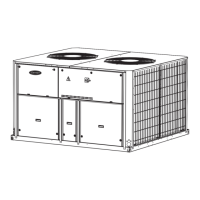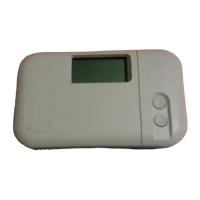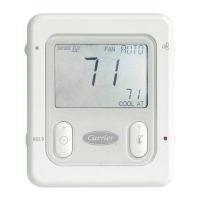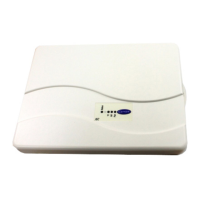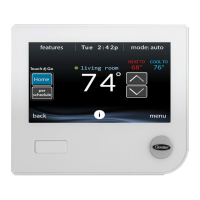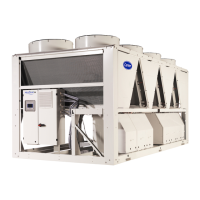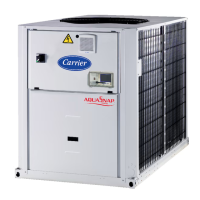Table 4 -- Status Screen
DESCRIPTION VALUE UNITS STATUS FORCE NAME
Terminal Mode HEAT MODE
Terminal Type SER FAN TYPE
Controlling Setpoint 69.0 dF CNTSP
Space Temperature 66.0 dF SPT
Damper Position 0 %OPEN DMPPOS
Supply Air Temperature 67.1 dF SAT
Local Heating Capacity 100 % HCAP
Terminal Fan On FAN
Relative Humidity 0.0 % RH
Demand Ventilation (ppm) 0 DCV
Primary Air Temperature 66.0 dF PATEMP
Heat Enable HEAT
Remote Start Off REMTCIN
PRIMARY AIR TEMPERATURE -- Primary air tempera-
ture fi'om sensor (10 kD., Type II), located in main trunk of
ductwork for supply air provided by the air source equipment.
Used for linkage coordination.
Prima q Air
Temperature: Display Units F (C)
Default Value 0.0
Display Range -40.0 to 245.0
Network Access Read/Write
HEAT (ENABLE/DISABLE) --Provides enable/disable func-
tion for local heat at the terminal. When enabled file Ix_c_d heat
capacity function will run to operate the termimd heat.
Heat Display: Display Units Discrete ASCII
Default Value Disable
Display Range Disable/Enable
Network Access Read/Write
REMOTE START -- This variable displays the value of the
remote timeclock input point that can be used for occupancy
override. The input point is configured as norm_dly open or
normally closed in the Terminal Service Configuration Table.
The occupancy mode of file zone controller will depend on the
configuration of file timeclock input and the value of the input
as follows:
REMOTE TIMECLOCK CONFIGURATION OCCUPANCY
INPUT
Off (default) Normally Closed Occupied
(default) (default)
On Normally Closed Unoccupied
Off Normally Open Unoccupied
On Normally Open Occupied
The user can ovemde file zone controller's unoccupied
mode by forcing Remote St_ut to On. The default state (Nor-
mally Closed and Off) is such that it may be used by controllers
that do not have remote timeclock wiring.
Remote
Start: Display Units Discrete ASCII
Default Value Off
Display Range On/Off
Network Access Read/Write
CONFIGURATION TABLES
The following sections describe the computer configuration
screens which are used to configure the zone controllel: The
screens shown may be displayed differently when using differ-
ent Cmrier software. See Table 5.
Alarm Configuration Table -- The Alarm Configura-
tion Table (ALARMLIM) contains decisions used to configure
the alarm settings for the zone controllel: This includes
re-almm time, routing of alarms, limits for space temperature
and demand control ventilation.
RE-ALARM TIME -- This decision is used to configure the
number of minutes the zone controller will wait before an ;darm
condition which has not been corrected will be re-transmitted
on the communications network. Re-alarming of an alarm
condition will continue until the condition no longer exists.
Alarm Re-Alarm
Time: Units Minutes
Range 0 to 1440
Default Value 0 (Disabled)
ALARM ROUTING CONTROL -- This decision indicates
which Carrier Propdet_uy Network system sollw_ue or devices
will receive and process alarms sent by the zone controllel: This
decision consists of eight digits each can be set to zero or one. A
setting of 1 indicates akums should be sent to this device. A
setting of zero disables ;darm processing for that device.
Currently the corresponding digits me configured for the
following devices: first digit -- user interface softwme; second
digit -- autodi;d gateway or Telink; fourth digit -- alarm
printer interface module; digits 3, and 5 through 8 -- unused.
Alarm Routing
Control: Range 00000000 to 11111111
Default Value 00000000
SPACE ]EMPERATURE OCCUPIED HYSTERESIS -- This
configuration defines the range above the occupied high set
point and below the occupied low set point that the space
temperature must exceed for an _flarm condition to exist during
occupied hours.
Space Temperature
Occupied
Hysteresis: Units delta F (delta C)
Range 0.0 to 99.9
Default Value 5.0
29

